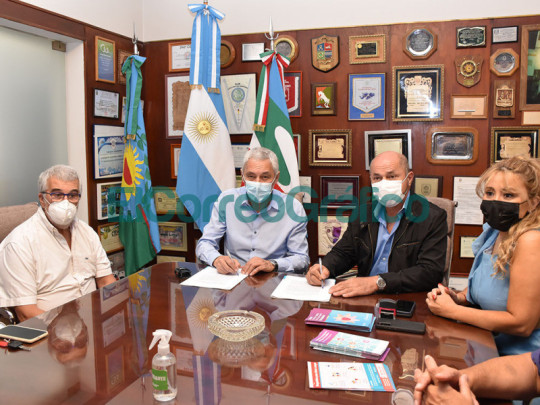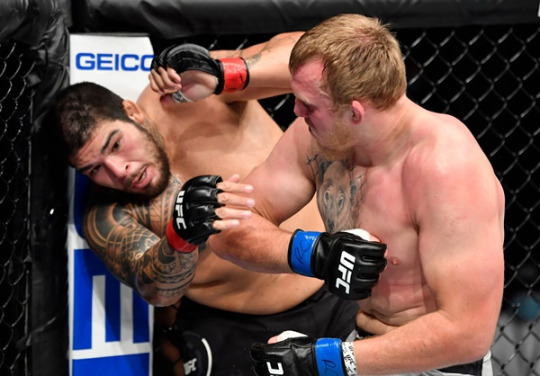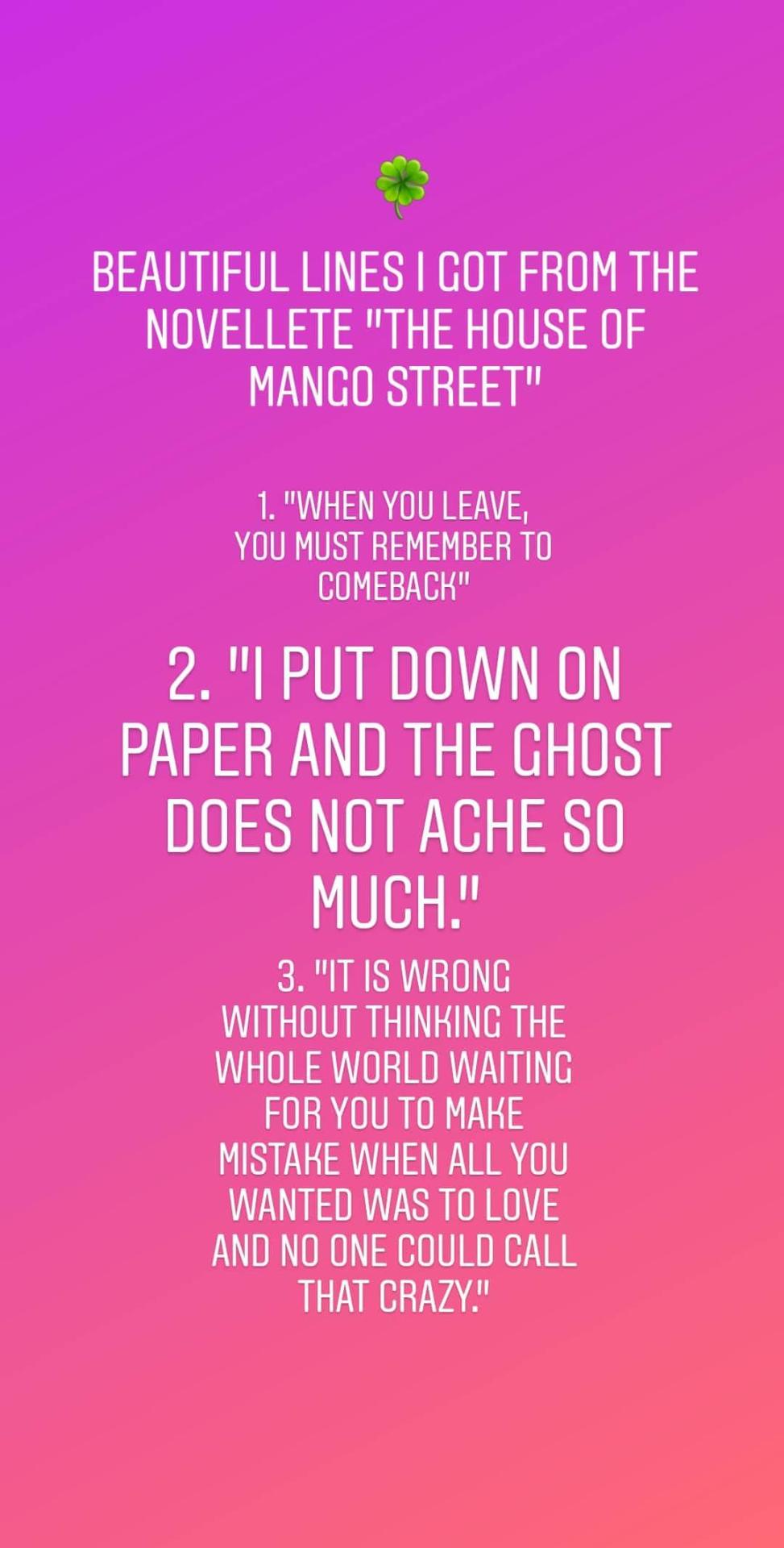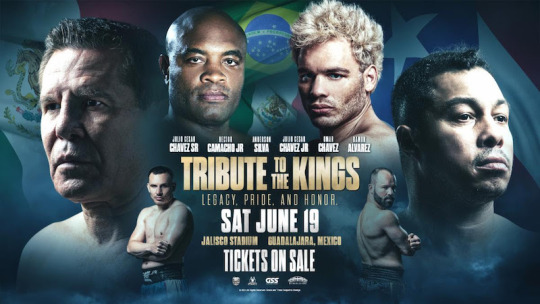#Carlos Spivak
Explore tagged Tumblr posts
Text
Convenio de Colaboración “Municipio Donante”
📬 Convenio de Colaboración “#MunicipioDonante” 📌 #Berisso #Ensenada #Institucionales 👇📲
El intendente de Berisso, Fabián Cagliardi, junto a su par de Ensenada, Mario Secco, firmó el Convenio de Colaboración Interinstitucional “Municipio Donante”.Este convenio, se llevó a cabo entre el Centro Único Coordinador de Ablación e Implante de la Provincia de Buenos Aires (CUCAIBA), el Hospital Interzonal Especializado-Perfil “D”, el Ministerio de Salud y el Municipio de Berisso. Cabe…

View On WordPress
#Acción Política#Almirante Brown#Berisso#Carlos Spivak#convenio de colaboración#COVID-19#CUCAIBA#Ensenada#Fabián Cagliardi#Francisco Leone#Hospital Interzonal Especializado-Perfil “D”#Instituto de Hemoterapia#Laura González#Mariana Estévez#Mario Secco#Martín Fernández#Municipio Donante#Villa Gesell
1 note
·
View note
Text
Sergey Spivak takes majority decision over Carlos Felipe.
It’s heavyweight so I wasn’t invested in this one, but seemed like a clear 2-1 for Spivack who also should have (and got) a 10-8 in the 3rd.
3 notes
·
View notes
Text
Chișinău, Moldova's Sergey Spivak earns first 2nd win at 'UFC Fight Night 172' on Yas Island, Abu Dhabi
Chișinău, Moldova’s Sergey Spivak earns first 2nd win at ‘UFC Fight Night 172’ on Yas Island, Abu Dhabi

Carlos Felipe, Sergey Spivak (©UFC)
Sergey “Polar Bear” Spivak (Сергій Співак), 25, earned his second victory in Ultimate Fighting Championship on Yas Island in Abu Dhabi, United Arab Emirates. Fighting out of Ukraine by way of Chișinău, Moldova, the Ukrainian-Moldovan mixed martial artist was one of the “UFC Fight Night 172” winners.
Featuring 12 MMA matches, “UFC Fight Night 172” took place on…
View On WordPress
#Abu Dhabi#Bahia#Brazilian MMA fighters#Carlos Felipe#Feira de Santana#Moldovan MMA fighters#Sergey Spivak#UFC Fight Night 172#Ukrainian MMA fighters#Yas Island
0 notes
Text
For present purposes, it will be enough to cite a particularly compelling example to illustrate how this discourse is now being applied to what used to be called the "Third World." That example is found in the work of Gayatri Spivak, who once remarked that "Class is the purest form of signifier," implying that class is a "pure" linguistic symbol in the sense that it has no concrete referent in the material world.(1) From the vantage point of the sort of linguistic theory on which so many postmodernist discourse analysts draw, the quality of the referent is less important than the location of concepts like class in relation to other "signifiers." So Spivak is able to say, for instance, that "socialism" has "no historically adequate referent" in India, by which she means that Indian socialism did not originate in a truly indigenous tradition of socialist discourse. Aijaz Ahmad has recently commented on this observation in a way that nicely captures the postmodernist notion of "history." To be told that socialism has no "historically adequate referent" in India, he remarks, would come as a big surprise to all those millions of Indians who, for reasons having to do with their own experience of their own domestic capitalism and their own situation in its class divisions, regularly vote Communist. The "historical referent" for Indian socialism, in other words, is not some disembodied imperial "discourse" but Indian capitalism and a political practice "undertaken within India by Indian political subjects."
Other essays in this issue outline the main characteristics of postmodernist "discourse." For present purposes, it will be enough to cite a particularly compelling example to illustrate how this discourse is now being applied to what used to be called the "Third World." That example is found in the work of Gayatri Spivak, who once remarked that "Class is the purest form of signifier," implying that class is a "pure" linguistic symbol in the sense that it has no concrete referent in the material world.(1) From the vantage point of the sort of linguistic theory on which so many postmodernist discourse analysts draw, the quality of the referent is less important than the location of concepts like class in relation to other "signifiers." So Spivak is able to say, for instance, that "socialism" has "no historically adequate referent" in India, by which she means that Indian socialism did not originate in a truly indigenous tradition of socialist discourse. Aijaz Ahmad has recently commented on this observation in a way that nicely captures the postmodernist notion of "history." To be told that socialism has no "historically adequate referent" in India, he remarks, would come as a big surprise to all those millions of Indians who, for reasons having to do with their own experience of their own domestic capitalism and their own situation in its class divisions, regularly vote Communist. The "historical referent" for Indian socialism, in other words, is not some disembodied imperial "discourse" but Indian capitalism and a political practice "undertaken within India by Indian political subjects."
That is one way of summing up the difference between postmodernism and Marxism. It isn't that Marxism is uninterested in language, discourse, or meaning, and the best historical-materialist work deals precisely with the many different concrete referents that words like "class" or "work" can have in specific historical conditions. But here I simply want to underline that Marxism can understand the practices through which meanings are produced in relation to the actions of people on and in the world and not just in relation to other meanings. Practices are undertaken in particular places at particular times by particular subjects in particular conditions, and these have to be studied historically.
Say, for instance, we want to analyze Mexican society, whether viewed through the prism of the Mexican revolution of 1910, or the neo-Zapatista revolution in Chiapas starting on January 1, 1994, or the crisis of the state and the ruling party in recent months. A starting point would be to recognize that Mexico has long been a "postcolonial society." Mexico has moved along temporally - if not developmentally - from an earlier colonial condition for almost two centuries. Yet one of the most striking features of the ways in which political power is organized socially and experienced subjectively throughout Mexico - whether in the "advanced" northern state of Chihuahua or the "backward" southeastern state of Chiapas - is that it is and remains a profoundly colonial or, in a pinch, neocolonial rather than unequivocally postcolonial form of power. Neither the Wars of Independence and the Wars of the Reform during the nineteenth century, nor the revolution of 1910 and the "re forms" of Salinastroika in the period 1988-1994 during the twentieth century, signalled irreversible, radical breaks with the past. Rather, they are moments in a sustained process of transformation. That series of political transformations was associated with a series of economic transformations that established the specific form of Mexican capitalism. The language of "pre" and "post," which pretends to be about historical change, actually disguises these processes of transformation by carving up history into discontinuous and disconnected units.
Nevertheless, the lure of intellectual fashion is so great that scholars who two decades ago worked with peasants in Mexico, and wrote about social movements, rural class formation, and the permanent character of the primitive accumulation of capital in dependent, peripheral states, now author postmodernist essays and books with titles (e.g., Hybrid Cultures) and themes (the metaphor of a salamander to organize reflections on Mexican history) that have more in common with magical realist literature than with historical materialist analysis. This is not to suggest that magical realism - say, the novels of Gabriel Garcia Marquez or Isabel Allende - has nothing to tell us, and that only historical materialism can reveal the Truth. It is only to underline the radical differences between literary and historical ways of relating to social reality.
Perhaps it should come as little surprise that some postmodern/postcolonial critics seem, or pretend, not to know that the arenas of discourse in which their work circulates are at several removes from the social reality they purport to represent. The privileges now enjoyed by intellectuals in the North have been so reduced that many seem to be compensating by providing to themselves an inflated sense of their own importance and the significance of purely intellectual or "discursive" practices. Nonetheless, the distinction between what is being talked about and how it is being talked about remains important. As Gabriel Garcia Marquez is reported to have said to Carlos Fuentes while discussing the turn taken by internecine struggles within the ruling party in Mexico in the early months of 1995, "We are going to have to throw our books into the sea. We've been totally defeated by reality." If a litterateur can get the point, why can't a literary theorist?
[...]
Why not interject some remarks of a Chihuahuan peasant, asked whether people in northern Mexico, followers of Francisco Villa, had joined the revolution in 1910 to recover control of their land? "Put it that we now have land," replied Cruz Chavez in 1986, but that was a fight. And justice? And freedom? When will we get that? Can you tell me? Look, we're gonna die of old age without seeing them, because the more time that passes, justice and freedom only get worse in our country.
Now I can imagine at least two different ways of connecting these remarks to what is happening in Chiapas today. We could simply take Cruz Chavez's words with those of Subcomandante Marcos and measure them both against some abstr-act repertoire of signifiers to find out, for example, whether they are pre- or postmodern discourses. Alternatively, we could consider these discourses historically, comparing the ways in which words like "freedom" and "justice" figure in their respective vocabularies, and how they relate to their concrete and changing historical referents, their material and social conditions, their political practices and struggles. We could consider as well how the labor process in Mexican agriculture has or has not changed since 1910, how political democracy has or has not advanced. And we could explore the ways in which the EZLN is trying in practice to answer the questions posed by Cruz Chavez in a different region of Mexico, under different historica l conditions, and building differently on a long history-including the 1910 revolution-of political struggle.
In the first case, it is hard to see how our objective as intellectuals could be anything else than to appropriate those discourses, to claim them as our own. In the second, we would simply be trying to understand and explain. The latter objective is in some ways more modest. At least it is less likely to exaggerate the power of intellectuals, because it acknowledges that we are talking about social and political practices undertaken by specific people other than ourselves, instead of claiming that our own discourse is the only real practice, our academic discourse the only real politics.
Daniel Nugent, Northern Intellectuals and the EZLN
#yeah...#the points raised here and in similar writings by aijaz ahmad and michael sprinkler etc speak to issues even present within what some peopl#that I generally respect fall victim to#like I really like Sarah Ahmed but in something like strange encounters she falls into these sorts of discursive traps pretty often often#and it affects the trajectory of her arguments in really substantial ways imo I mean it's evidenced by the fact the the book itself despite#making routine/exculpatory allusions in the opposite direction she's mostly just discussing academic discourses and their already assumed#significance despite never situating them in relation to actual political/historical trends/actions etc#but like you're penned in that way by the way that any argument based in these critical premises will inevitably proceed#it parallels similar crucial limitations/weaknesses even in the work of writers that don't abide by the critical dictates of#postmodern/poststructuralist though like mark fisher slavoj zizek etc#essays#*
5 notes
·
View notes
Text
Regionalismo Critico
El regionalismo crítico es una aproximación a la arquitectura que lucha para contrarrestar la falta de espacio y la falta de identidad del Estilo Internacional, pero también rechaza el individualismo caprichoso y la ornamentación de la arquitectura posmoderna. Los estilos del regionalismo crítico buscan proporcionar una arquitectura arraigada en la tradición moderna, pero vinculada al contexto geográfico y cultural. El regionalismo crítico no es simplemente regionalismo en el sentido de arquitectura vernácula.

Kenneth Frampton En Hacia un regionalismo crítico: seis puntos para una arquitectura de resistencia, Frampton recuerda el "cómo llegar a ser moderno y volver a las fuentes" de Paul Ricoeur, cómo revivir una civilización antigua y adormecida y participar en la civilización universal ". De acuerdo con la propuesta de Frampton, el regionalismo crítico debería adoptar la arquitectura moderna, críticamente, por sus cualidades progresivas universales pero, al mismo tiempo, debe ponerse un valor en el contexto geográfico del edificio. El énfasis, dice Frampton, debería estar en la topografía, el clima, la luz; en forma tectónica más que en escenografía y debería estar en el sentido del tacto en lugar del sentido visual. Frampton recurre a la fenomenología para su argumento. Dos ejemplos que Frampton discute brevemente son Jørn Utzon y Alvar Aalto. En opinión de Frampton, la Iglesia de Utzon’s Bagsværd , cerca de Copenhague, es una síntesis autoconsciente entre la civilización universal y la cultura mundial.

William JR Curtis y Suha Ozkan Ha habido dos percepciones diferentes de regionalismo en la arquitectura. Una de ellas es de escritores occidentales, como Curtis, cuyas definiciones no abarcan lo suficiente como para analizar los estilos arquitectónicos especialmente en los últimos dos siglos en los países islámicos, como Irán.


Alexander Tzonis y Liane Lefaivre Según Alexander Tzonis y Liane Lefaivre, el regionalismo crítico no necesita extraer directamente del contexto; más bien, los elementos pueden ser despojados de contexto pero usados en formas desconocidas.


Arquitectos regionalistas críticos Además de Aalto y Utzon, los siguientes arquitectos han utilizado el Regionalismo crítico en su trabajo: Studio Granda, Mario Botta, Eduardo Souto de Moura, Mahesh Naik, Mazharul Islam, BV Doshi, Charles Correa, Christopher Benninger, Álvaro Siza, Jorge Ferreira Chaves, Rafael Moneo, Geoffrey Bawa, Raj Rewal, Dharmesh Vadavala, Ashok "Bihari" Lall Neelkanth Chhaya , Soumitro Ghosh, Nisha Mathew Ghosh, Tadao Ando, Mack Scogin / Merrill Elam, Glenn Murcutt, Johnsen Schmaling Architects, Ken Yeang, Philippe Madec, William SW Lim, Tay Kheng Soon, WOHA Architects , Juhani Pallasmaa, Wang Shu, Juha Leiviskä, Peter Zumthor, Carlo Scarpa, Tan Hock Being. Peter Stutchbury, Lake Flato, Rick Joy, Tom Kundig, Sverre Fehn, Dimitris y Suzana Antonakakis son los dos arquitectos griegos para quienes el término fue utilizado por primera vez por Tzonis y Lefaivre.



En estudios culturales Posteriormente, la frase "regionalismo crítico" también se ha utilizado en estudios culturales, estudios literarios y teoría política, específicamente en el trabajo de Gayatri Chakravorty Spivak. En su obra de 2007, "Who Sings the Nation-State?", En coautoría con Judith Butler, Spivak propone una alternativa deconstructiva al nacionalismo que se basa en la deconstrucción de las fronteras y la identidad nacional rígida.

youtube
youtube
2 notes
·
View notes
Text
A Critical Analysis on the Novel “The House on Mango Street” by Sandra Cisneros

About the Author
Poet, novelist, essayist, short story writer, and children’s author Sandra Cisneros was born in Chicago, Illinois, the only daughter in a family with six sons. Her father was a Mexican who was very close to his family and her mother was an American-Mexican who lived most of her life in Chicago. During her childhood, the family moved often between Chicago and Mexico. Cisneros earned a BA at Loyola University of Chicago and an MFA at the University of Iowa.
Her writing frequently engages with the construction of feminist Latina identity, folding Spanish phrases into a hybrid, spiraling syntax that crosses languages as her characters shift between cultures. In an interview for the New York Times, Cisneros discussed the experience and power of shifting between cultures and languages, stating, "I'm a translator. I'm an amphibian. I can travel in both worlds. What I'm saying is very important for the Latino community, but it is also important for the white community to hear. What I'm saying in my writing is that we can be Latino and still be American."
Source: https://www.poetryfoundation.org/poets/sandra-cisneros
Synopsis
The novel The House on Mango Street was written by a Mexican author whose name is Sandra Cisneros. The story is about Esperanza who is living in the House of Mango Street with her family. This story tells the description of the people residing in that place with different stories as described in different chapters of the novel. Herein, she connected each on in to her own life with her own perspective as to how she sees each of them. This story might be a novel but the chapter included herein are just short just giving the audience the glimpse of the lifestyle of people in that place. And because it is evident in the lifestyle of the people there that Mango Street is a poor place, Esperanza tries to escape from that place because she feels the place is not for her to live comfortable like how she has seen Lucy and Rachel who came from Texas, Esperanza is jealous with them. Along the course of the stories, there is an arousing desire of Esperanza to stay away that is why she goes along with others like of Sally and Alicia reason why she is molested by group of boys which made her more determined to get out of the place. At the end of the day, she is perceived by the aunts of Lucy and Rachel to be special and saved them for her to stay away from that place.
Analysis
The novel might be confusing at the first glance because there are a lot of chapters included inside the novel. However, in the whole course of the novel, this story gets interesting because the narrator who is Esperanza tries to intervene to each character to connect each scenario which made the novel more interesting. The following are analyses of the novel in anchor with claims by different authors in Comparative Literature:
A. The illustration of the House on Mango Street as symbol of Subalternity
Comparative Literature has tackled about the idea of being ‘Subaltern’. According to Gayatri Chakravorty Spivak, subaltern refers to people who are poor or in a low state, women, soldier, peasants, slaves and the like. As quoted, she claims that ‘the subaltern has no history and cannot speak’. This concept is very present in the novel.
Esperanza and the rest of her family members living in The House of Mango Tree
If you are wondering why Esperanza wants to escape from the place, it is because the place is so poor. Herein, there is a representation that she and her family are said to be subaltern as evident in these lines:
“But the house on Mango Street is not the way they told it at all. It's small and red with tight steps in front and windows so small you'd think they were holding their breath. Bricks are crumbling in places, and the front door is so swollen you have to push hard to get in. There is no front yard, only four little elms the city planted by the curb.” This lines describe how poor the place of mango street is and the house itself.
Esperanza’s family is poor as well, that is why her mother and her father are dreaming to have a luxurious house which is very opposite to their state in the story. Here are the lines of the dream house of Esperanza’s parents, “Our house would be white with trees around it, a great big yard and grass growing without a fence. This was the house Papa talked about when he held a lottery ticket and this was the house Mama dreamed up in the stories she told us before we went to bed.”
Women Maltreated by Men
It is very evident in the story that there is a dominance of men to women. Women are also treated as subaltern because of the social position that women have which is very present in the story.
“Then we didn't need to worry. Until one day Sally's father catches her talking to a boy and the next day she doesn't come to school. And the next. Until the way Sally tells it, he just went crazy, he just forgot he was her father between the buckle and the belt. You're not my daughter, you're not my daughter. And then he broke into his hands.” This lines talk about Sally is hardly beaten by her own father even at first she did admit it.
Another evidence is not Minerva who married at a young age. She is innocent that is why, without her husband, she doesn’t know what to do. That is why in this line although her husband causes her many troubles in life, she still forgives her husband and that makes her martyr. “She has many troubles, but the big one is her husband who left and keeps leaving. One day she is through and lets him know enough is enough. Out the door he goes. Clothes, records, shoes. Out the window and the door locked. But that night he comes back and sends a big rock through the window. Then he is sorry and she opens the door again. Same story.”
B. Women’s common experiences
In relation to the first, analysis Women as Subalterns, this next analysis talks about the common struggle of women in the story. As being discussed in her claims, Chandra Talpade Monhanty describes women as sisters in struggle. These are women who are called to be postcolonial women. And since nationality Esperanza is Spanish, she belongs to women who are in the third world, these are the women being placed in the periphery and considered as the other.
Women who are victims of male violence.
This is evident to how Sally is being maltreated by her father in the story as presented in this lines, “Then we didn't need to worry. Until one day Sally's father catches her talking to a boy and the next day she doesn't come to school. And the next. Until the way Sally tells it, he just went crazy, he just forgot he was her father between the buckle and the belt.”
Another is when Esperanza being molested by group of men and her innocence is being abused by Sally her friend, “Sally Sally a hundred times. Why didn't you hear me when I called? Why didn't you tell them to leave me alone? The one who grabbed me by the arm, he wouldn't let me go. He said I love you, Spanish girl, I love you, and pressed his sour mouth to mine. Sally, make him stop. I couldn't make them go away. I couldn't do anything but cry. I don't remember. It was dark. I don't remember. I don't remember. Please don't make me tell it all.”
Women as Universal Dependent
This means that women are powerless and that they are dependent always to the men. One of the examples in the novel is Minerva whom husband is invisibly abusing her right as woman by just letting her take good care of the children and that herein, Minerva is illustrated as one who is too dependent to her husband that without him, she has nothing to do. One day she is through and lets him know enough is enough. “Out the door he goes. Clothes, records, shoes. Out the window and the door locked. But that night he comes back and sends a big rock through the window. Then he is sorry and she opens the door again. Same story. Next week she comes over black and blue and asks what can she do? Minerva. I don't know which way she'll go. There is nothing I can do.”
C. The concept of Hybridity being present in the novel
The fact that the setting of the story is at Chicago and Esperanza’s nationality is Spanish
Esperanza’s hybridity is shown when she and the rest of her family members came from different places to reside in. Now, the setting of the story is at Chicago but she is a Spanish is an evidence that she and her family are hybrids. As evident into these following lines:
“We didn't always live on Mango Street. Before that we lived on Loomis on the third floor, and before that we lived on Keeler. Before Keeler it was Paulina, and before that I can't remember. But what I remember most is moving a lot. Each time it seemed there'd be one more of us. By the time we got to Mango Street we were six-Mama, Papa, Carlos, Kiki, my sister Nenny and me.” (Chapter 1, Page 3)
“Then the colors began to whirl. Sky tipped. Their high black gym shoes ran. Sally, you lied, you lied. He. wouldn't let me go. He said I love you, I love you, Spanish girl.” (Chapter 39, Page 100)
The existence of Lucy and Rachel in the story is also a representation of Hybridity
“We come from Texas, Lucy says and grins. Her was born here, but me I'm Texas. You mean she, I say. No, I from Texas, and doesn't get it.” (Chapter 6, page 14) In the story, there is the illustration of the jealousy of Esperanza to kind of lifestyle they have. That is why Esperanza is trying to imitate them as seen that they are both beautiful.
And also, aside from Lucy and Rachel, there are other characters in the novel that illustrate hybridity because of different lifestyles Esperanza has described all throughout the novel.
D. Noticeable act to Emancipate
Emancipation means an act to escape from one’s culture to the other. This concept is first coined by France Fanon. He believes that the reason for someone’s emancipation is the lost of identify when a person is in a particular society. And emancipation is evident in the story and the most manifesting to the main character Esperanza. If you are going to integrate those of the ideas above, those are the reason why the main character wants to impasse.
Esperanza’s companionship with Lucy and Rachel; Esperanza being with Sally
This is anchored to the idea of emancipation because Esperanza wants to stay away from the kind of a lifestyle she has with Nenny and her family. That is why, being with Lucy and Rachel is such a relief for her and her envy to the both of them is an illustration of her trying to be like them, “Nenny and I don't look like sisters ... not right away. Not the way you can tell with Rachel and Lucy who have the same fat pop side lips like everybody else in their family. But me and Nenny, we are more alike than you would know. Our laughter for example. Not the shy ice cream bells' giggle of Rachel and Lucy’s family, but all of sudden and surprised like a pile of dishes breaking. And other things I can't explain.” (Chapter 7, Page 17)
“Sally, do you sometimes wish you didn't have to go home? Do you wish your feet would one day keep walking and take you far away from Mango Street, far away and maybe your feet would stop in front of a house, a nice one with flowers and big windows and steps for you to climb up two by two upstairs to where a room is waiting for you.” (Chapter 32, page 81)
Esperanza has finally decided to leave the Mango street
At the end of the story, Esperanza realizes that the Mango Street is a place which is always be part of her but will not be her. “One day I will pack my bags of books and paper. One day I will say goodbye to Mango. I am too strong for her to keep me here forever. One day I will go away. Friends and neighbors will say, What happened to that Esperanza? Where did she go with all those books and paper? Why did she march so far away? They will not know I have gone away to come back. For the ones I left behind. For the ones who cannot out.” (Chapter 43, Page 110) . And that she is dedicated to leave the place because the place brought her so much pain and that she does not want to be there anymore.

Even if it is hard. If a thing does not make us happy anymore, then let go.
2 notes
·
View notes
Text
Astor Piazzolla - Oblivion (piano solo sheet music)
Astor Piazzolla - Oblivion (piano solo ver.) has been added to our sheet music Library. Astor Piazzolla"Music is the most direct art, it enters through the ear and goes to the heart." Please, subscribe to our Library. Thank you! Best Sheet Music download from our Library.
Astor Piazzolla - Oblivion (piano solo ver.) has been added to our sheet music Library.
https://youtu.be/Y6VsBx7baOo

Astor Piazzolla
"Music is the most direct art, it enters through the ear and goes to the heart." Born on March 11, 1921 in Mar del Plata, Buenos Aires province. He was a bandoneon player and composer. His contact with music began in New York, where his family lived between 1925 and 1936. At the age of eight, his father gave him his first bandoneon , and he began to take classes with Andrés D'Aquila; he made a recording on acetate when he was only ten years old, without commercial purposes. In 1933, he studied music with the Hungarian pianist Bela Wilda, who introduced him to the sound universe of Bach. The following year, he met Carlos Gardel and quickly became friendly with him. Gardel heard him play and offered him to participate and play several songs in the film El día que me quieras; in which he played a newsboy. He was also invited to the tour of America in which Gardel lost his life along with his team; but, given his young age, he did not travel because he did not have permission. In 1936, his family returned to Mar del Plata, and Astor participated in various ensembles and became acquainted with the work of the Elvino Vardaro sextet, which influenced him definitively. Determined to explore tango, he moved to Buenos Aires at the age of seventeen and, shortly after, he achieved his goal: to join the Aníbal Troilo orchestra , first as a bandoneonist and occasional pianist and, later, as an arranger for the orchestra. He continued his studies in academic music with Alberto Ginastera and, in piano, with Raúl Spivak. His arrangements distanced him more and more from classical tango. Around 1944, he left the Troilo Orchestra to direct the orchestra that accompanied the singer Francisco Fiorentino until 1946, when he composed El desbande, considered by himself his first tango with a different formal structure. He formed his own orchestra, which he disbanded in 1949, and began writing music for films. He moved away from the bandoneon and approached jazz: the search for a different style led him to deepen his musical studies. Between 1950 and 1954, he composed works clearly different from the conception of tango up to that time ( To show off , Tanguango , Prepare , Contrabajeando , Triunfal , What will come ), and began to define his style. Also at this time, he wrote pieces of music cultured, such as Rhapsody of Buenos Aires (1952) and Buenos Aires, three symphonic movements (1953). For the latter, he won the Fabien Sevitzky Prize, and the French Government awarded him a scholarship to study in Paris with the famous musical pedagogue Nadia Boulanger, who convinced him to continue on the path of tango: «Astor, your scholarly works are fine written, but here is the real Piazzolla, never abandon him». The fellowship lasted for almost a year, and in that time, he formed a string orchestra with Paris Opera musicians Martial Solal and Lalo Schifrin. With Schirfrin, he recorded Two Argentinians in Paris (1955). Upon his return to Argentina, he summoned top-class musicians and formed the Octeto Buenos Aires. It was made up of Enrique Mario Francini and Hugo Baralis, on violins; Roberto Pansera, on bandoneon; José Bragato, on cello; Aldo Nicolini, on bass; Horacio Malvicino, on electric guitar, and Atilio Stampone, on piano. Various versions of the Octet had a decisive influence on the future evolution of tango, due to their rhythmic and contrapuntal novelties. When his father died in 1959, he composed perhaps his most beautiful work in his tribute: Goodbye, Nonino . In 1960, after a stay in the United States, where his style was presented as jazz-tango, he formed a quintet that included musicians such as Elvio Bardaro, Dante Amicarelli, Antonio Agri, Horacio Malvicino, Oscar López Ruiz, Kicho Díaz, Osvaldo Manzi and Cacho Tirao. In 1968, he composed, with the poet Horacio Ferrer, the opera María de Buenos Aires , for eleven instruments, female and male reciter and singers. In 1969, she began to write, also together with Ferrer, simpler songs for the voice of Amelita Baltar, her partner in those years. They composed Balada para un loco , which became a great popular success that was followed by others. In 1972, after a heart attack, she decided to settle in Italy for five years. She formed the Conjunto Electronico, recorded Libertango and experienced her approach to jazz-rock. In 1974, she recorded Summit with saxophonist Gerry Mulligan; and, a year later, after the death of Aníbal Troilo, the album Suite Troileana . In 1976, she appeared at the Gran Rex theater with her play De ella 500 Motivaciones ; and, in 1977, with a series of concerts at the Olympia in Paris. In 1978, she returned with her Quintet and consolidated her international fame with tours of Europe, South America, the United States and Japan. In 1983, at the Teatro Colón, he offered a program entirely composed by him. In 1984, he performed with the singer Milva and produced the album Live at the Bouffes du Nord ; in Vienna, she recorded Live in Wien with the Quintet. In 1985, he was named an Illustrious Citizen of Buenos Aires ; and he premiered, in Belgium, at the Fifth International Guitar Festival, the Concert for Bandoneon and Guitar: Homage to Liège , conducted by Leo Brouwer. In 1986, he received the César Award in Paris for the soundtrack of the film El exilio de Gardel ; and he recorded live, together with Gary Burton, Suite for Vibraphone and New Tango Quintet , at the Montreux jazz festival (Switzerland). In 1987, he presented himself with a massive recital in Central Park (New York). In 1988, he recorded his last album with the La Camorra Quintet. In 1989, he formed Sexteto Nuevo Tango, with which he performed at the Teatro Ópera, toured, and appeared as a soloist until its dissolution at the end of that year. On August 4, 1990, in Paris, he suffered a cerebral thrombosis that left him bedridden. He died on July 4, 1992, in Buenos Aires. Read the full article
0 notes
Photo

Ensenada: Internas en Juntos
En Ensenada, el jefe comunal K presentó oficialmente su lista de candidatos para las PASO. En lo que hace a las principales fuerzas opositoras, el Frente Juntos irá a internas, mientras que la sorpresa la dio Vicente “Pachuli” Ignomiriello que encabezará la nómina del Frente Vamos con Vos de Florencio Randazzo.La lista sequista de Frente de Todos la encabeza el docente Daniel Eseiza, Ornela Grilli, Esteban Spivak, Nora Turconi, Jonathan da Cruz, Andrea Giúdice, Simón Medina, Rossana Vellanich y Fabián Gutiérrez. Como concejales suplentes, irán Rocío Basso, Ezequiel Antognini, Daiana Martínez Barrientos, Pablo Ivañez, Yésica Merino y Diego Carmona.Asimismo, la nómina del Consejo Escolar la completan Cristina Ríos, Jorge Marchioni y Viviana Bustos. Como suplentes, Federico Birocho, Valentina Cejas y Ricardo Pérez Sbrascini.La nómina que representa a los partidos Pro, en alianza con Hacemos y otros sectores, lleva como precandidato a Leandro “Peto” Rojas, la integran Carolina Dil, Guillermo Cebrian, Griselda Gotelli, Juan Ramón Juárez, Cintia Elichondoborde, Ramón Dario Medina, Emilce Ramírez y Ramón Acuña, Stella Maris Palomeque, Ángel Rodríguez, Pamela Beltrami, Sergio Larrosa, Mónica Erramuspe, Marcelo Amigorena.Los aspirantes a consejeros escolares titulares serán Agustina López, Nicolas Castro Cladis, Maria Victoria Marina. Suplentes Mateo Roselot Flammini, Noelia Alegre y Diego Chilperico.Sin embargo, en el distrito la sorpresa fue la precandidatura de Vicente “Pachuli” Ignomiriello, hombre que abandonó las filas del Frente Renovador y ahora apuesta a ser el representante del Frente Vamos con Vos de Florencio Randazzo.A la candidatura de Ignomiriello, le siguen Maira Gisela Yaniz, Rodolfo Cristian Pavón, María Luisa Tortosa, Matías Segovia, Romina Valeria Riche, Julio Cesar D’ Elia, Cintia Cigara, Fabio rolando Córdoba y Nilda Alejandra Galeano, Erik José Luis.Los consejeros escolares serán: Federico Raúl González, Olga Salinas, Luis Sebastián Rodríguez. Suplentes Gina Luján Principi, Adrián Alejandro Pro y Marcela Monteguro.La lista que encabeza Asnaghi, lleva también a María Marta Gianastassio, Carlos Oscar López, Linda Debora Yael Aidar, Guillermo Ariel Vargas, Rosa Teresa Noble, Sergio Marcelo Dauma, María Laura Díaz, Rodolfo Hugo Castillo. Como concejales suplentes a Susana Beatriz Díaz, Rodolfo José Medina, María Rosa Galli, Héctor Claudio Viciconti, Olga Ester Gimenez y Luis Omar Gómez. La lista de consejeros escolares será: Mónica Graciela Giammatolo, Carlos Alberto Arcuri, María Belén Piugmarti, Rafael Alfredo Pastore Solari, Almendra Pesado y Guillermo Jorge De Stefano.El Frente Juntos disputará la interna del sector. La nómina con gran componente radical del distrito, lleva como precandidatos a Gustavo Asnaghi y María Marta Gianastassio, y pretenden ganar la disputa interna a la lista del Pro y otros sectores encabezada por Leandro “Peto” Rojas y Carolina Dil.
NTS #Ensenada #PASO2021 #Elecciones #TerceraSeccion #PBA #BuenosAires
1 note
·
View note
Link
0 notes
Text
Mario Secco agredió e insultó a un bombero voluntario
#Ensenada #Política #TerceraSección | #MarioSecco agredió e insultó a un #bomberovoluntario
El intendente ultra kirchnerista de Ensenada, Mario Secco quedó demostrado que es un violento al defenestrar a un bombero voluntario en servicio. En plena navidad hay gran revuelo en la localidad de Ensenada por un hecho de violencia sucedido en las últimas horas que involucra a ni más ni menos que el intendente kirchnerista, Mario Secco, y un empleado municipal llamado Edgardo “El Indio”…

View On WordPress
#bombero voluntario#Carlos Gabriel Zerpa#Edgardo “El Indio” Reyes#Ensenada#Esteban Spivak#Facebook#Mario Secco
0 notes
Photo










Combat Sports for the Week of 6/14/2021
God, I have not posted one of these in like 5 years but I was looking at what was happening this week and there was so much good stuff I figured I’d share.
PFL 2021 #5: Regular Season - 6/17/2021 - The welterweight and light heavyweight regular season will conclude on this one. Rory MacDonald, Gleison Tibau, Ray Cooper III, Emiliano Sordi, Chris Camozzi, Cezar Ferreira, Antonio Carlos Jr, Vinny Magalhaes, Curtis Millender, and more will all be fighting for a spot in the PFL playoffs and a shot at $1 million.
RISE 150 - 6/18/2021 - The RISE 65kg champion Kosei Yamada will look for revenge when he puts up his title as he faces off with Katsuki Kitano.
UFC Fight Night: Korean Zombie vs. Ige - 6/19/2021 - All action main event featuring Dan Ige trying to make himself a contender as he’s set to face off with the Korean Zombie. Also featured on this one is Chito Vera vs Davey Grant, Kanako Murata vs Virna Jandaroba, Tim Means vs Danny Roberts, Aleksei Oleinik vs Sergey Spivak, and a few other notable fights. Should be a good action card.
Triller Fight Club: Teofimo Lopez vs George Kambosos Jr. - 6/19/2021 - Fresh off the biggest win of his career against Lomachenko, Teofimo Lopez will face off with his mandatory defense against undefeated Aussie George Kambosos Jr. On the undercard, we got a big women’s fight as well! Undefeated Swedish boxer Elin Cederroos and former US national team member Franchon Crews-Dezurn will face off to crown an undisputed champion for the women’s super middleweight division. Big night.
Naoya Inoue vs Michael Dasmarinas - 6/19/2021 - Super Bantamweight Monster Naoya Inoue continues his concurring of the U.S. as he returns to ESPN to face off with his mandatory Michael Dasmarinas as he waits for a big fight to make itself available. On the undercard, we have a big women’s boxing match on tap as Mikaela Mayer defends his WBO super featherweight championship against longtime veteran and former world champ Erica Anabella Farias.
Jaime Munguia vs Kamil Szeremeta - 6/19/2021 - Mexican middleweight Munguia will face off with a last minute replacement in Kamil Szeremeta. On the undercard, Olympic bronze medalist Marlen Esparza will face off with champion Ibeth Zamora Silva for the WBC flyweight title.
Jermall Charlo vs Juan Macias Montiel - 6/19/2021 - The undefeated Charlo will defend his WBC middleweight title against mandatory, Juan Montiel. Montiel is coming off a 1st round KO over James Kirkland.
Tribute to the Kings - 6/19/2021 - Julio Cesar Chavez Jr vs former UFC middleweight champion Anderson Silva and Julio Cesar Chavez Sr. vs Hector Camacho. Just fantastic.
Deep Jewels 33 - 6/19/2021 - Ignore the date on the poster, the card was postponed to this week. Judoka, wrestler, and sumo-ist(?) Seika Izawa challenges for the DJ strawweight title against champion Miki Motono in a rematch. Plus we have the semis and finals of DJ’s atomweight tournament.
DEEP Tokyo Impact 2021 ~2nd Round~ - 6/19/2021 - A card featuring a bunch of interesting Japanese up and coming talent, like Naoki Hirata and Kouya Kanda.
There’s some other interesting fights sprinkled about out there but these were the ones I thought yall would want to know about. If there’s ever another week with a bunch of cool stuff going on and I have time, I’ll try to throw another one of these together.
14 notes
·
View notes
Text
'UFC Fight Night 172' fight card: Deiveson Figueiredo vs Joseph Benavidez, Jack Hermansson vs Kelvin Gastelum on Yas Island, Abu Dhabi
‘UFC Fight Night 172’ fight card: Deiveson Figueiredo vs Joseph Benavidez, Jack Hermansson vs Kelvin Gastelum on Yas Island, Abu Dhabi

Promotion: Ultimate Fighting Championship (UFC)
Title: “UFC Fight Night 172” (UFC on ESPN+ 30)
Venue: UFC Fight Island, Yas Island, Abu Dhabi, United Arab Emirates
Date: July 19, 2020
Number of bouts: 12
Bout #
FIGHTERS
Sport
Red Corner (Country)
Blue Corner (Country)
PRELIMINARY CARD 1 Sergey ” Polar Bear” Spivak (Moldova) Carlos “Boi” Felipe (Brazil) Heavyweight
RE…
View On WordPress
#Abu Dhabi#Deiveson Figueiredo#Jack Hermansson#Joseph Benavidez#Kelvin Gastelum#UFC Fight Night 172#UFC on ESPN+ 30#Yas Island
0 notes
Text
Berisso se suma al Programa “Comunidades sin Violencia”
#Berisso se suma al Programa “Comunidades sin Violencia” #Política #IdeologíadeGénero #Institucionales
El intendente de Berisso, Fabián Cagliardi, junto a la ministra de Mujer, Genero y Diversidad de la provincia de Buenos Aires, Estela Díaz y el intendente de Ensenada, Mario Secco, firmaron Convenios que ponen en marcha el programa “Comunidades Sin Violencia”, el cual busca brindar asistencia a las víctimas de situaciones de violencia de género.El mencionado Programa, comprende el fortalecimiento…

View On WordPress
#Berisso#Buenos Aires#Carlos Dabaloni#Comunidades sin Violencia#Desarrollo Social Lucas Spivak#diversidad#Ensenada#Estela Díaz#Fabián Cagliardi#Flavia Delmas#género#Marina Peñalba#Mario Secco#mujer
0 notes
Photo

🌎 #Berisso | #Sociedad | #Política | #Institucionales 📬 #DíadelasPersonasSordas: #FabianCagliardi cambió una señalética en el #ParqueCívico de la gestión #JorgeNedela 💻 El 19 de septiembre se celebra en nuestro país, el Día Nacional de las Personas Sordas, por lo cual desde la Municipalidad de Berisso se realizó una intervención en el Parque Cívico de un cartel donde se consigna el alfabeto en lengua de señas argentino (LSA), colocado en la gestión de Jorge Nedela, ahora con los colores partidarios de Fabián Cagliardi.
#19 de septiembre#Adriana Caballero#Asociación Amigos de Corazón#Asociación Civil “Mis manos hablan así”#Berisso#Carlos Penesi#Consejo Municipal#Cristian Mena#Derechos Humanos#Desarrollo Social#Día Nacional de las personas sordas#Fabián Cagliardi#Irene Domínguez#Javier Ibarra#Jorge Nedela#lengua de señas argentino#LSA#Lucas Spivak#Martín Fernández#Parque Cívico#personas con discapacidad
0 notes
Text
Con el encendido de la lámpara votiva y la reinauguración del Monumento a los Inmigrantes, dieron inicio las actividades en Berisso de la “40° Fiesta Provincial del Inmigrante”.
La jornada de este domingo por la tarde comenzó en la sede de la Colectividad Helénica y Platón, en un acto que estuvo encabezado por el intendente Jorge Nedela y la presidenta de la Asociación de Entidades Extranjeras (AEE) Gabriela Ruszczyk. Los mismos estuvieron acompañados por la actual Reina Provincial del Inmigrante Aldana Santillán Armoha y las princesas Giuliana Martins Balducci y Ludmila Wac Galuk; las nuevas Reinas Infantiles y Juveniles de las colectividades, abanderados, representantes de las entidades extranjeras, funcionarios municipales, concejales y un gran marco de público.
Luego de interpretar las estrofas del Himno Nacional Argentino, hicieron uso de la palabra la presidenta de la AEE Gabriela Ruszczyk y el jefe comunal Jorge Nedela, quienes agradecieron el trabajo de todos los que desde distintos lugares hacen sus aportes a la festividad local y convocaron a vivir la “40° Fiesta Provincial del Inmigrante” con todas las energías y el sentir berissense.
En el salón de la colectividad Griega de calle 8 y 164, un grupo de representantes de la entidad ofrecieron una presentación especial recordando los Juegos Olímpicos de Atenas. La representación incrementó las emociones de la tarde y el encendido de la antorcha que se traspasó luego a manos de una de las atletas que participó de la tradicional Posta, guardó momentos especiales entre los presentes.
Un grupo de sesenta atletas autoconvocados participaron este año de la Posta del Inmigrante, recorriendo un trayecto que les llevó más de una hora y que pasó por cada una de las colectividades con sede en nuestra ciudad.
Tras cumplir con el circuito previsto en el que también reinas, abanderados y representantes de cada entidad recibió la llama inmigrante, los atletas llegaron al Centro Cívico, donde fueron aguardados por una gran marco de público, a pesar de la tarde fría y el asecho de la lluvia que se tomó un descaso para que se realicen los festejos.
El deportista berissense Carlos Spivak, que representa a la ciudad en distintos certámenes para personas trasplantadas, tuvo el honor en esta oportunidad de encender la lámpara votiva que acompañará todo el mes de actividades de la Fiesta Provincial del Inmigrante.
De esta manera se puso en marcha el programa de actividades de la “40° Fiesta Provincial del Inmigrante”.
Reinauguración del Monumento a los Inmigrantes
Otro momento especial de este domingo, fue la Reinauguración del Monumento a los Inmigrantes emplazado en el Centro Cívico de la ciudad. Bajo una idea de la AEE, el Municipio llevó adelante las tareas de remodelación y nueva imagen que muestra un nuevo diseño.
La realización presenta la imagen de las banderas de las colectividades que integran la AEE. El orden representa primero a las colectividades fundadoras: Albania, Líbano, Siria, Palestina, Armenia, Belarús, Bulgaria, Eslovaquia, España, Italia, Lituania, Polonia y Yugoslavia. Luego siguen por orden alfabético las que se fueron sumando con el paso de los años: Alemania, Cabo Verde, Croacia, Grecia, Eslovenia, Irlanda, Israel, Ucrania y Portugal y cierran las recientemente incorporadas; Colombia, México y Uruguay.
En la oportunidad la presidenta de la AEE hizo entrega al intendente municipal una réplica del Monumento a los Inmigrantes por la colaboración del Municipio, mientras que Nedela dejó una placa para ser colocada en el lugar y que recuerda los 40 años de la Fiesta Berissense, en el año de los 60 años de Autonomía de la ciudad.
This slideshow requires JavaScript.
Próximas actividades
Las actividades previstas en el programa de esta “40º Fiesta Provincial del Inmigrante” continuarán este lunes 4 de septiembre, fecha en la que se celebrará una Misa en la Iglesia María Auxiliadora, ubicada en calle 10 entre Avenida Montevideo y 166, en el marco de la celebración por el Día Nacional del Inmigrante.
Posteriormente, a las 20 horas, se llevará a cabo en la sede de la Sociedad Italiana (Av. Montevideo N°841 entre 10 y 11) un acto en homenaje a la primera Comisión Directiva y presidentes a lo largo de los cuarenta años de la A.E.E.
El viernes 8 a las 18,30 horas, se realizará por primera vez un Encuentro de Coros “Sonidos Inmigrantes”, con entrada libre y gratuita, en las instalaciones del Instituto Canossiano San José de (166 entre 11 y 12).
Ya el sábado 9, a las 20 horas la recientemente refaccionada sede de la Sociedad de Bomberos Voluntarios (8 y 164) será escenario de la Presentación de las Reinas Juveniles, quienes formalmente harán su primera aparición y serán agasajadas por las autoridades ante la comunidad. Durante la actividad habrá números artísticos.
Por su parte, el domingo 10, a las 9:00 horas, tendrá lugar la “Maratón del Inmigrante” que partirá desde el Parque Cívico, y a las 15:00 horas se concretará la Presentación de Reinas Infantiles en la Unión Polaca de calle 9 entre 164 y 165 Nº 4222.
Adelantos del programa 2017
Entre los momentos más destacados de la Fiesta Provincial del Inmigrante se encuentran el sábado 16, a las 18:00 horas la Entrega de Diplomas a Inmigrante en la Unión Polaca (9 N° 4222) y posteriormente, a las 19:00 se dará inicio al concurso de Comidas Típicas “Los Sabores de Berisso” que recupera recetas tradicionales. El encuentro se llevará a cabo en el Hogar Árabe Argentino, ubicado en calle 11 N° 4077.
El domingo 17, desde las 15 horas se registrará uno de los momentos más emotivos que es el Desembarco Simbólico recreando la llegada de los inmigrantes al Puerto Local. La cita es en la explanada del Puerto La Plata, Avenida Montevideo y 2.
Las jornadas de festivales de colectividades y patio de comidas típicas tendrán lugar en la carpa mayor ubicada en el Parque Cívico, en Avenida Montevideo entre 10 y 11, con entrada libre y gratuita, los fines de semana del 22 al 24 de septiembre; 29 y 30 de septiembre y 1 de octubre; y el último fin de semana de actividades será del 6 al 8 de octubre en el que se efectuará el sábado 8 la elección de la Reina Provincial del Inmigrante y el domingo 8 a partir de las 15 horas el tradicional desfile de cierre con la participación de todas las Colectividades luciendo sus trajes típicos sobre la Avenida Montevideo desde calle 16 hasta calle 8.
Se encendió la Llama Inmigrante, #Berisso vive su mes de #FiestaProvincialdelInmigrante Con el encendido de la lámpara votiva y la reinauguración del Monumento a los Inmigrantes, dieron inicio las actividades en Berisso de la “40° Fiesta Provincial del Inmigrante”.
#4 de septiembre#AEE#Albania#Aldana Santillán Armoha#Armenia#Asociación de Entidades Extranjeras#Belarús#Bulgaria#Cabo Verde#Carlos Spivak#Colectividad Helénica y Platón#Colombia#Croacia#Día Nacional del Inmigrante#Encuentro de Coros "Sonidos Inmigrantes"#Eslovaquia#Eslovenia#España#Fiesta Provincial del Inmigrante#Gabriela Ruszczyk#Giuliana Martins Balducci#Grecia#Irlanda#Israel#Italia#Jorge Nedela#Líbano#Lituania#Ludmila Wac Galuk#Maratón del Inmigrante
0 notes
Text
El intendente de Berisso Jorge Nedela recibió al deportista berissense Carlos Spivak, con el fin de otorgarle un subsidio para poder participar de la competencia Mundial de Juegos para Personas Trasplantadas, la cual se llevará a cabo en la ciudad de Málaga, España del 25 de junio al 2 de julio.
Del encuentro, llevado a cabo en el despacho de Intendencia, participaron también los secretarios de Gobierno y Promoción Social, José Méndez y Manuel Simonetti respectivamente, quienes hicieron entrega de una bandera de la ciudad y una remera para llevar al campeonato.
Spivak, quién recibió un trasplante de hígado hace siete años, es miembro de la comisión del Hogar de Tránsito dependiente del INCUCAI, que funciona en el Dique, Ensenada donde las personas antes y después de haber sido trasplantadas, reciben alojamiento y alimentos gratis.
Al respecto de esta iniciativa del Municipio, el deportista Carlos Spivak expresó: “Como ciudadano berissense estoy muy agradecido por todo el apoyo que nos ha dado el Municipio, tanto al Hogar de Tránsito y a mí en particular en este momento. Formo parte de la comisión del hogar, donde todos somos trasplantados y trabajamos para que la gente tome conciencia y que donde sus órganos”.
“Este es mi primer Mundial, y mi fuerte es el paddle. El año pasado competí en el Nacional y en el sudamericano que fueron las instancias clasificatorias” agregó el deportista.
This slideshow requires JavaScript.
#Berisso Subsidio para #CarlosSpivak, quién participará del Mundial de Juegos para personas Trasplantadas @DeportesBerisso El intendente de Berisso Jorge Nedela recibió al deportista berissense Carlos Spivak, con el fin de otorgarle un subsidio para poder participar de la competencia Mundial de Juegos para Personas Trasplantadas, la cual se llevará a cabo en la ciudad de Málaga, España del 25 de junio al 2 de julio.
#Carlos Spivak#España#Hogar de Tránsito#INCUCAI#Jorge Nedela#José Méndez y Manuel Simonetti#Málaga#Mundial de Juegos para Personas Trasplantadas
0 notes